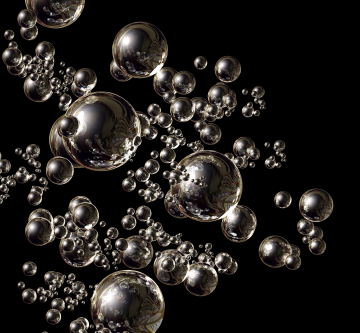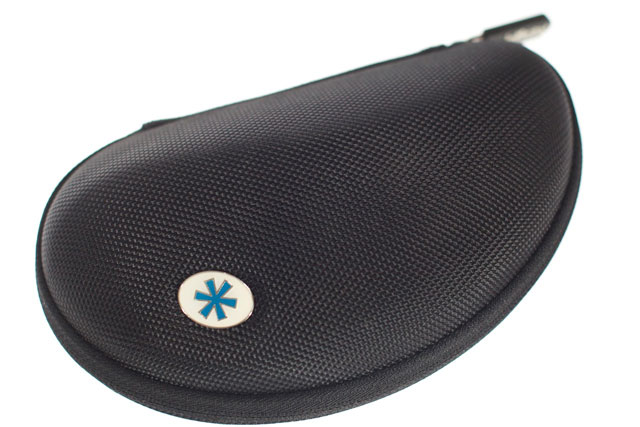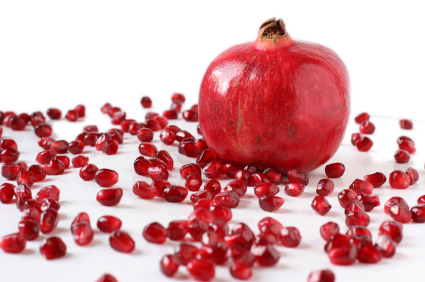Wednesday Bubble: Cool is the new black
What are the odds that I would run across yet another cooling product? Seriously, it’s like a flash went off in someone’s brain that every menopausal woman in the United States needed to solve her issues through cooling. Mind you, I do believe that thermoregulation is an interesting strategy to combat the body’s out of whack thermometer. But when does the menopausosphere reach its saturation point?
Evidently, not yet.
This week, I bring you the Polar Pillow, guaranteed to “calm, cool and soothe you into the best sleep of your life” (as well as soothe hot flashes and night sweats).
This nifty 12+ pound pillow contains cooling gel infused with micro air beads and according to the manufacturer, works on its own by absorbing coolness from the air and then releasing it upon contact. The ‘science’ behind the Polar Pillow is an abstract presented at the Associated Professional Sleep Society 2011 meeting. In this study, researchers asked 12 people with insomnia to wear a cap that contained circulating water at cooling and varied temperatures. With the cap on, study participants with sleep issues took an average of 13 minutes to fall asleep (compared to 16 minutes for the healthy comparators) and they slept for about 89% of the time that they were in bed. Theoretically, the benefits are related to the fact that the brain (namely the frontal lobe) remains too hot to sleep and by cooling it down, one can turn down processes that keep the brain active and alert.
So, where do the night sweats and flashes come in?
They don’t.
At least not in the small pilot research that was conducted thus far.
However, rather than asking you to take my cynical word on the Polar Pillow, I decided to ask my friend Richard Laermer (who I inadvertently learned has used the pillow) to weigh in. And while Richard told me that he likes it because he’s a “hot” sleeper and it does cool him, he said that “it’s ugly and it seems to smell sometimes,” adding that it’s not him since he’s “fairly clean!” But here’s the rub:
” There are really really rough pointy edges that almost blinded my partner,” said Richard. “Go figure. Meanwhile, I wouldn’t recommend it…we can do better for a hundred bucks.” (Richard received it as a gift.)
So, let’s see:
- It’s ugly
- It smells
- It has really rough pointy edges making its utility in bed dangerous for one’s partner
And while it may cool the average hot sleeper, it has not actually been shown to help menopausal women. (Clearly, Richard is neither a women or menopausal.) And, despite being the target hot sleeper, Richard still wouldn’t recommend the Polar Pillow.
My take away?
Thermal is in. Cool is the new black. Enough said.
Read More
Your Weather Forecasting is Spot On! Guest post by Susie Hades, Founder, Personally Cool, Inc
You may recall that about a week ago, I took the mick out of ColdFront, a new personal cooling system designed to cool those hot flashes. The day that the post ran, ColdFront inventor and Personally Cool Founder Susie Hades posted a comment with an offer to provide with me a sample so that I could try it for myself. Although I turned Susie’s offer down, I did reach out to her via email and phone and we had a lengthy conversation about her vision and the product. And you know what? I was impressed by her philosophy and approach, so much so that I offered her a guest spot on Flashfree.
Part of my mission is to reveal products and agents that work and that don’t, to uncover snake oil approaches and provide data-driven alternative solutions. Mostly though, I believe that information is truly power AND empowering, and that by educating ourselves, we are in a better position to play a role in driving and shaping decisions about our health and our healthcare.
Susie’s goal is not unlike mine and I encourage you to show some love. And Susie? I am glad that we had a chance to exchange ideas and start what is certain to be more than one conversation. We need more of those exchanges if we are ever going to move menopause out from under the Menopause Industrial Complex and into the hands of women who want viable and safe solutions.
I founded Personally Cool in 2007 because I couldn’t find what I call an “and” product for hot flash relief: drug-free; AND effective; AND safe; AND convenient; AND discreet; AND elegant; AND eco- and wallet-friendly.
I must have bought and tried one of almost every type of hot flash relief product available with the exception of bio-identical or hormone replacement therapy (HRT). Even though the efficacy was unquestionable, the data tell a larger story for HRT.
In 2002, increased risks of breast cancer, stroke, and a number of other side effects were widely expressed across various studies. As a result, prescriptions of Prempro (a leading Wyeth/Pfizer HRT product) dropped 80% by the fourth quarter of 2003.[1] Women, frightened and confused by the findings of these studies, wanted other choices.
Our own research (both initial and a just-completed survey of 300 women) confirms that women are still looking for safe alternatives to HRT. We also learned a number of other interesting facts – from how often and with what severity women hot flash, to how they handle them. Two poignant realities were derived from this last point. First, more than 80% of the women we surveyed had either never used HRT or they stopped at the advice of doctors or of their own volition. Second, more than 55% of the women currently experiencing hot flashes – given the choices they’ve faced until now – deliberately choose to do nothing at all. In other words, they literally sweat them out.
I invented coldfront to be the “AND” product that other products aren’t, and I am proud to say that it is. A test panel conducted late in our product development to make sure that we got it right was critically helpful. We abandoned certain product features that we loved but that our intended audience didn’t. After testing coldfront for three days, over 80% of our panelists reported that they’d never use anything other than coldfront to relieve their hot flashes. This was huge!
Yes, coldfront is great at cooling a hot flash, but we couldn’t ignore larger forces at work – the enormous need for psychological and social relief from the stigma of menopause. Although we’re living up to a third of our lives post-menopause, our society still sees menopausal women in an unflattering light. Among women my age, there is a growing desire to reassert control over our own lives and bodies, and to put a stop to allowing other people to define for us what this time of life should mean. Personally Cool wants to change the perception of midlife women and create our own conversation. When we say, “we make menopause cool,” we mean it – on a number of levels!
With coldfront, we are encouraging women to take charge of their own relief, which – in our case (pun totally intended!) – is no farther away than your handbag and no more complicated than what we already know works – cold – especially when it’s in the palm of your hand. It is so discreet and convenient that it allows most women to get through a hot flash without letting anyone know they’ve even had one.
And this, ultimately, is what sets coldfront apart from every other cold therapy product available today:
- coldfront was designed in every way to be compatible with the life of a menopausal woman who defines herself, simply, as a woman. It is the least intrusive, most effective, complete, and portable cold therapy system for hot flashing women on the market.
- coldfront can go right from the freezer to your bag because it was engineered to be condensation-free. Your bag, phone, or iPad will not get wet; you won’t be uncomfortable; and you don’t have to worry about batteries or enlarging your “carbon footprint.”
- Each woman experiences hot flashes differently and in different parts of their bodies. The two palm packs are formulated to last the average length of a hot flash, 1-3 minutes, and they can go wherever a woman needs them. After replacing them back in the case, within 20 minutes they will be cool again and ready for use.
- Hot flashes make you sweat! The antimicrobial super absorbent cloth wicks away moisture and is easily washed.
- Your day is long, and you’re not always near a freezer. coldfront will continue re-cooling the palm packs for up to 12 hours.
- Unlike one-time use cold packs, which can create over 600 pounds of toxic waste over the course of five hot-flashing years, and literally cost thousands of dollars, coldfront is phthalate-free, non-toxic, and costs less than $100 over the life of the product.
- Everything in the system is reusable and is designed to last.
Liz, thank you for the opportunity to contribute to your community and to speak about our product. Because women all experience menopause and hot flashes differently, we know that coldfront won’t be for everyone. But, we believe deeply that coldfront is something special – not just because it works, but because it speaks to a societal issue we believe we can change.
Here’s to a new kind of coldfront moving in!
Susie
[1] http://www.fugh-berman.com/files/Perspectivespro.pdf
Soy…revisited
 It’s been a rough ride for soy, with studies often at odds regarding its effectiveness in ameliorating or preventing hot flashes. Some reviews have shown that soy isoflavones, in particular S-equol and genistein can alleviate hot flashes while others fail to finding anything conclusive. Still, the original observation that Japanese women appear to suffer less frequently from hot flashes and have a high consumption of soy isoflavones has led researchers to keep trying to tease out the benefits of soy.
It’s been a rough ride for soy, with studies often at odds regarding its effectiveness in ameliorating or preventing hot flashes. Some reviews have shown that soy isoflavones, in particular S-equol and genistein can alleviate hot flashes while others fail to finding anything conclusive. Still, the original observation that Japanese women appear to suffer less frequently from hot flashes and have a high consumption of soy isoflavones has led researchers to keep trying to tease out the benefits of soy.
I am glad that they have. In fact, in a study published online in Menopause just a few weeks ago, researchers reported that an extensive review of 19 scientifically sound trials has shown that soy isoflavones are significantly more effective than placebo in reducing both the frequency and severity of hot flashes.
Here’s what you need to know:
- 19 trials were included for analysis and a variety soy isoflavone supplements in different doses ranging from 30 mg to 135 mg daily were studied. Some of these were natural formulations and others, chemically synthesized to match key ingredients believed to have a health effect.
- Hot flash severity and frequency were examined in women that were either premenopausal, perimenopausal or menopausal (i.e. postmenopausal) although definitions used to define this group differed between studies.
- The number of women in these studies totalled over 1,200.
The results showed that taking 30 to 80 mg soy isoflavones daily for 6 months to a year significantly reduced the frequency of hot flashes by roughly 17%. Moreover, the 10 trials analyzed for hot flash severity showed a significant reduction by as much as 30%. In both cases, these figures increased depending on how the researchers teased out and analyzed the data.
The researchers say that even though there is a common perception that results from soy trials have been mixed, there has been a “consistent and clear pattern in favor of isoflavones over placebo” when properly plotted on a graph. Moreover? The scientifically designed studies that were included in their analysis helped to insure that all populations, including women with breast cancer, were included. Additionally, they analyzed studies that were as short as 6 weeks in duration, namely to determine if women with cancer not receiving treatment would respond the same as healthy women. Additionally, there is some indication that the effectiveness of soy actually increases over time with continuous use.
What about the type of soy isoflavone? This review actually shows that genestein is more effective than daidzein for alleviating hot flashes.
The key take away is that for women who don’t want to use hormone replacement or are ineligible to do so, there is a scientifically proven effective alternative: soy. And while soy may disturb the GI tract in some women, it is actually quite safe, even among women with breast cancer.
So far, so good. The next step is to determine which factors matter most to gain benefit, e.g. dose, formulation, hot flash frequency and how long a woman needs to remain on treatment.
Read MoreFlash dance? Yeah, maybe!
Did you ever watch Flashdance, the 1983 film that tanked in reviews but went on to be one of the highest grossing films that year? Guess it says a lot about our culture. Still, I am not going to say that I didn’t find it entertaining, or that Michael Nouri wasn’t hot in his day. But I digress…
For some reason, the film’s title came to mind when I stumbled across study that examined whether or not aerobic activity could ameliorate hot flashes and night sweats, perhaps because a lot of us dance around the issue rather than address it until it gets intolerable. Or perhaps because it makes a catchy header. Or maybe because Jennifer Beals works up such a sweat during her stand-in’s routine.
Regardless, on the heels of last week’s three-parter on ‘Forties fitness’ and motivating women, I thought I’d share some interesting information regarding physical activity, namely aerobic exercise.
Exercise. I’ve been pushing it for years because for me, it’s my drug of choice. What else offers benefits that include endorphins, wellbeing, bone health, metabolic booster and weight maintenance? And who would have thought that just 5o minutes, four times weekly could have a significant effect on the main cause of menopause flooding, including irritability, clothing changes, sheet replacement and crummy sleep?
That’s what researchers are reporting in Menopause. They discovered that when they assigned menopausal women to 6 months of aerobic training, the women experienced dramatic changes in mood swing, night sweats and irritability. Briefly, the women were divided into two groups:
- 50 minutes unsupervised aerobic training that with walking or Nordic walking (walking with ski poles) at least twice a week added to walking, Nordic walking, jogging, cycling, swimming, skiing, instructed aerobics or step class twice a week, plus two health lectures or,
- Health lectures twice weekly
They researchers were able to track target heart rates (64% to 80% of maximal) because the women in the aerobic training group were monitored and then given feedback All the women also reported the frequency/severity of menopausal symptoms (frequency of night sweats, mood swings, irritability, depressive mood, headache, vaginal dryness and urinary symptoms).
Although declines in symptoms (except vaginal dryness) were seen in both groups (which accounts for what they call a placebo effect, common to all studies), reductions in the prevalence of night sweats, mood swings and irritability were significant only in women engaging in regular aerobic activity. What’s more, because the women recorded their symptoms via a mobile phone, the likelihood that recall issues might come into play were reduced.
So, what about other studies that haven’t shown any benefit from exercise? The researchers point out that in their study, all the women had fairly substantial rates of symptoms (e.g. up to 60% had night sweats, 25% depression/irritability and 30% headache) while in other studies, the numbers at the start of the trials haven’t been quite as robust.
The upshot is that f you don’t care to jump on the hormone train, it can’t hurt to give aerobic activity a whirl. Just be sure to speak to a certified trainer and your health practitioner before diving in.
Read More
Pomegranate seed oil and hot flashes
Let us go early to the vineyards to see, if the pomegranates are in bloom… Songs of Solomon 7:12
Pomegranates have had a place in the bible and many religions for centuries. A shrub fruit native to the Middle East, the pomegranate is valued in culinary and in complementary and folk medicine circles. As a fruit, there is none so tempting and tantalizing as the pomegranate – its seeds, both sweet and tart, are challenging to obtain and sensual in appearance.
Pomegranate seed oil is a rich source of phytoestrogens, plant-like compounds with estrogen properties that may influence estrogen receptors and modulators in the body. Its main components include linolenic acid (an unsaturated fatty acid that is in the omega-3 family), punicic acid (a conjugated polyunsaturated acid) and ellagic acid (an antioxidant found in many fruits and vegetables). Studies in mice suggest that pomegranate oil may be helpful in lowering blood pressure, counteracting insulin resistance and preventing prostate, colon, lung and breast cancer. Because of its estrogenic properties, it may also be useful for menopausal symptoms. Or not.
A study that appears in the online version of Menopause explores the value of pomegranate seed oil for hot flashes in 81 women. Over a 12 week period, these women received either capsules, twice daily, that contained 30 mg pomegranate seed oil or placebo capsules containing sunflower oil. All women participating in the study were in menopause for at least a year and reported having at least five hot flashes a day. None had taken hormone therapy within 3 months of starting the study, which of course, could affect results.
Women taking pomegranate oil experienced significant benefits, reducing the mean number of hot flashes by 4.3 a day. However, women taking placebo also reported significant reductions in hot flashes by as much as 2.5 per day. After 12 weeks, the pomegranate oil group had a reduction in hot flash frequency by as much as 38.7% compared to the placebo group, who had reductions by as much as 15.6%. Based on these numbers, it would appear that pomegranate seed oil was indeed, significantly more effective than placebo, right? However, the researchers say that the total reduction in the frequency of hot flashes was no different between women taking pomegranate oil and those taking placebo. At the same time? When they tracked the women past this time period (up to 24 weeks), they found that the differences remained, suggesting that the effects of pomegranate oil may be sustainable and even take a longer treatment time to reach its full effect. This warrants looking into its potential with larger studies of longer duration.
One thing to mention is that it did appear that pomegranate seed oil also benefited other symptoms, in particular sleeping disorders, which is in line with other studies looking at isoflavones. And, no side effects or serious adverse events were reported.
So does it or doesn’t it? Undoubtedly, the placebo effect plays a role in all clinical studies, whether or not they are focused on pharmaceutical treatments or complementary therapies. Other studies of phytoestrogens have shown mixed results and a small number have met the criteria for scientific design. Still, there is a question about the role that time plays; many herbal medicines are well known to take some time before reaching full potency in the body in order to exert any sort of intended effect.
I say that the verdict on pomegranate seed oil isn’t in yet. It’s not the panacea we’d like to see but it also isn’t a flat out failure.
Meanwhile, I love that I once heard chef Jose Andres suggest that the best way to access its seeds is to pat it like a baby’s bottom.
Stay tuned for more news on this jewel of the fruit world.
Read More









